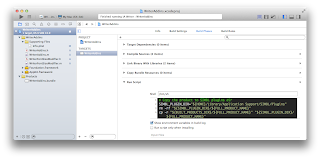What is SIMBL ?
As the wiki says, SIMBL is an application enhancement (InputManager bundle) loader for Mac OS X developed by Mike Solomon. Now a days SIMBL is not maintained anymore but there is a new version of it called EasySIMBL, maintained by Nomura-san.In short, it is a plugin loader for any Cocoa Application in OSX. So, If you have an app you want to hack (lets say add some extra functionality) to an App and that app does not brings Plugin functionality then EasySIMBL is your option.
First Steps
- Download and Install EasySIMBL.
-
Create an Xcode project
File > New > Project > OS X > Framework & Library > Bundle

-
Follow further instructions from "Creating A SIMBL Plugin Bundle" from old SIMBL wiki page.
Basically, make sure your Info.plist haveSIMBLTargetApplicationswith appropriate values inBundleIdentifier,MaxBundleVersionandMinBundleVersion.
For the more curious, there is an undocumented parameter:RequiredFrameworks. See details here. It says it has never been used but I personally think it could be useful in cases when your plugin requires a non-standard framework which is embedded in the target app. Using this key load your plugin only if the required frameworks exist. - Start by implement load method as explained in the old wiki.
-
Once you build your plugin you can move it manually onto EasySIMBL and set the Debug level to "Notice + Info + Debug" to see a bit more of information about the loading process of your plugin

- Open Console.app and see "All Messages" now open the target App and check what happens...
Debug
Obviously the process of manually copying the .bundle to~/Library/Application\ Support/SIMBL/Plugins is tedious.
We can do it a bit better:
# Copy the product to SIMBL plugins dir
SIMBL_PLUGIN_DIR="${HOME}/Library/Application Support/SIMBL/Plugins"
rm -rf "${SIMBL_PLUGIN_DIR}/${FULL_PRODUCT_NAME}"
cp -r "${BUILT_PRODUCTS_DIR}/${FULL_PRODUCT_NAME}" "${SIMBL_PLUGIN_DIR}/${FULL_PRODUCT_NAME}"
However, in the end this is not what we want. We want to be able to run the target app with the plugin and be able to set breakpoints, etc!.
Setting Xcode for plugin development
This step is not specific to EasySIMBL. Basically every plugin in OSX can be developed/debbuged in this way:-
Tell Xcode where to place product after build.
In our case the location is:"~/Library/Application Support/SIMBL/Plugins". Do this by editingCONFIGURATION_BUILD_DIRon your target:
 .
.
Note that some apps (that support plugins without the need of EasySIMBL) will require the plugin to be in~/Library/Application Support/TheApp/Plugins/or sometimes in/Applications/TheApp/Contents/Plugins. Just make sure you have enough access permissions so Xcode can write there (Hint: use chmod if needed).
For example iPhoto.app -
Tell Xcode what application to start on "Run".
In my case I just created a example plugin for Writer.App (That awesome app!). So I edit my schema. Product > Scheme > Edit Scheme...

- Specific to EasySIMBL. EasySIMBL seems not to load correctly the latest version of the plugin on Sandboxed apps. Nomura-san says he is aware of this issue and it can be work-arounded by un-checking and checking the "Use SIMBL" before each time we run our plugin. This is basically all. This is my 1 cent and comments are welcome :)
0 comments :
Post a Comment